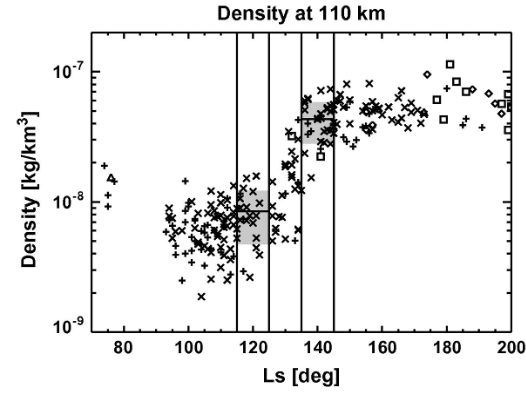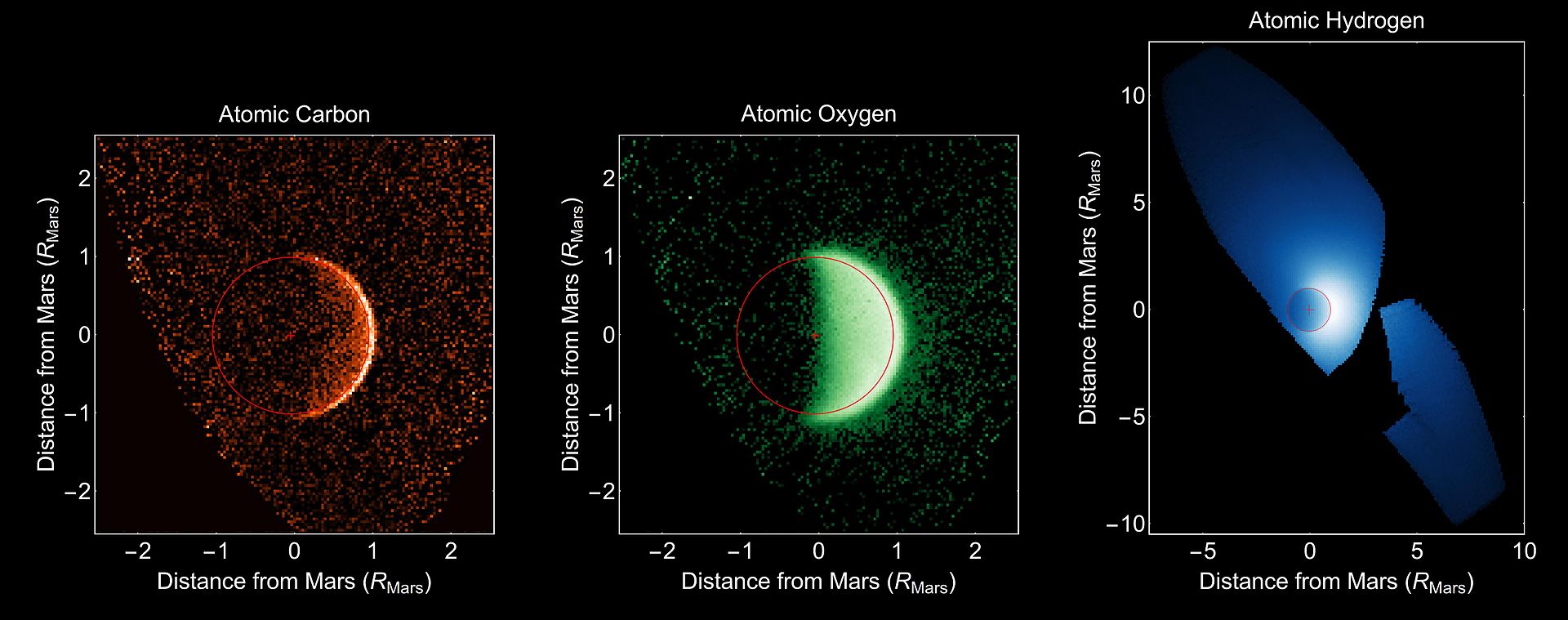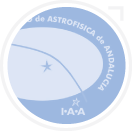Atmosphere
The thermosphere of Mars can be considered as a transition region between the lower atmosphere and the exosphere, the region where species can escape from the planet. Its physical state significantly affects the atmospheric escape, and hence its knowledge, including its variability, is required in order to understand the escape and its long-term evolution.
Despite its importance, the thermosphere is probably the most unknown region of the Martian atmosphere. Most of the information of this region comes from the aerobraking manoeuvres performed by the MGS, MO and MRO spacecrafts, and from the stellar occultations taken by SPICAM/Mars Express. The latter have allowed to derive temperature and density profiles, and to explore, for the first time, the seasonal and geographical variability of the thermosphere. The data prove that the Martian thermosphere is a complex and dynamically-active region, strongly affected by the coupling with the lower region. Thus, the effects of dust storms and the strong temperature variations in the lower atmosphere are clearly felt in the thermosphere. A global view of the atmosphere, from its interaction with the surface at the bottom to its exchange with space at the top, is required to understand this region.

Curiosity Approaching Mars, Artist's Concept. NASA
The thermospheric datasets described above have limited temporal and geographical coverage. Also, important aspects as the influence of the solar activity can be hardly explored with them. In particular, except part of the MGS aerobraking dataset, all of them are concentrated in the nightside. The dayside thermosphere, where solar radiation effects are stronger, i.e., directly by heating due to UV absorption and indirectly through the atmospheric expansion of the lower region caused by the dust absorption, remains almost unexplored.

This computer simulation, based on data from NASA’s Mars Atmosphere and Volatile Evolution, or MAVEN, spacecraft, shows the interaction of the streaming solar wind with Mars’ upper atmosphere. MAVEN is gathering information on the space environment at Mars—information that will be key to planning a human mission to Mars in the 2030s. Credits: X. Fang, University of Colorado, and the MAVEN science team
New perspectives
Several instruments on board Mars Express have observed daytime atmospheric emissions in the IR, and in the UV. Although temperature and density can be retrieved from them, these datasets are far from being fully exploited in the UV (e.g., the dayglow and H Lyman-alpha) or not at all in the IR. Some of them cover several Martian years, which open new perspectives as the inter-annual variability and the 11-year solar cycle effects, crudely addressed so far. Overall, they will provide a wider and deeper vision of the upper atmosphere, of its variability, and of its coupling with the lower atmosphere. We propose here to fully exploit those datasets.

Typical temperature profile of the Martian atmosphere
Thermospheric temperatures have been previously derived from these data but only marginally. Also, the most ambitious goal of deriving atmospheric densities has not been performed. We propose to derive the temperature profiles from the whole dataset and to retrieve, for the first time, the CO and CO2 density profiles. This dataset will complement the time and spatial coverage of those derived from the IR. A comprehensive model of these emissions (airglow) will be developed and implemented on a 1-D numerical model. The CO and CO2 densities in the dayside upper atmosphere will be derived from the model/observations comparison.

The densities measured at 110 km by SPICAM (vertical axis) suddenly increase when a regional dust develops (around Ls=130, after Withers and Pratt, 2013; Ls measures the orbital/seasonal period of Mars around the Sun). These changes can have dramatic effects on the aerobraking phase of orbiting spacecrafts. UPWARDS aims at detecting and understanding the magnitude and variability of these changes and other dynamical and chemical couplings with the lower atmosphere by exploiting a unique MEx dataset (in daytime conditions) unexploited so far.
The obtained temperatures and densities will be analysed by using a state-of-the-art Mars GCM, the LMD-MGCM, which couples all the physics, chemistry and dynamics relevant for the Martian atmosphere from the surface to the exosphere. In particular we plan to: a) look for correlations with previous night-time data; b) check the consistency of the CO retrievals; c) study the coupling with the lower atmosphere (strongly relate to the outcome of the water cycle and the dust and aerosols work packages); and d) produce, for the first time, global and dynamical (in time) maps of the UV dayglow. The latter will be achieved by developing a fast version of the airglow model to be used in the LMD-MGCM model.
Water vapour
Water vapour escapes to space in the form of atomic hydrogen, H. The hydrogen escape is therefore an important clue for the evolution of Mars water. This escape strongly depends on the temperature and density of the thermosphere, and on the amount of water vapour in the lower atmosphere. H will be derived in the upper atmosphere from its Lyman-alpha emission measured by SPICAM on Mars Express. Because of its large optical thickness, the inversion is not straightforward and challenging, requiring radiative transfer models with resonance multiple scattering. The H escape rate will then be further deduced from the H measurements. Some SPICAM data have already been analysed. Here we plan to perform the retrieval of the latest six years of SPICAM measurements (not done yet) and combine them with the available data.
The whole set of H data will then be analysed with the 3D LMD-MGCM model; expected to be improved in this project with a) the new water vapour that will be generated (WP1) and b) the water cycle (WP4). In particular, we will study the H seasonal and solar cycle variability, the episodic Lyman-alpha variations observed by SPICAM; and will look for potential correlations to dust load in the lower atmosphere.

Mars's escaping atmosphere—carbon, oxygen, hydrogen—made by MAVEN UV spectrograph).
Summary outcome: First-time densities in the dayside atmosphere from 60 to 160 km. First-time 3-D map of UV airglow emissions consistent with data. Coupling with lower atmospheric dust/thermal conditions and water cycle impacts on atmospheric escape.
Dedicated Work Package: WP7
Links to other UPWARDS activities: WP1, WP4, WP5, WP6, WP8, WP9
Related Papers
Keating et al., Science, Vol. 279, pp. 1672-+(1998)
Keating et al., paper presented at the European Planetary Science Congress 2009, Postdam, Germany (2009) 74Forget et al., J. Geophys. Res.,Vol. 114, E01004 (2009)
Bougher et al., J. Geophys. Res. Lett., Vol. 33,L02203 (2006)
Keating et al., Paper presented at the European Planetary Science Congress 2009, Postdam, Germany (2009) 77Bougher et al., J. Geophys. Res., Vol. 104, pp. 16591-16611 (1999)
López-Valverde et al., Planet. Space Sci., Vol. 53, pp.1079-1087 (2005)
Formisano et al., Icarus, Vol. 182, pp. 51-67 (2006)
Gilli et al., Planet. Space Sci., Vol. 59, pp. 1010-1018 (2011)
Leblanc et al., J. Geophys. Res., Vol. 111, E09S11(2006)
Simon et al., Planet. Space Sci., Vol. 57, pp. 1008-1021 (2009)
Cox et al., J.Geophys.Res., Vol.115, E04010 (2010)
Chaufray et al., Icarus, Vol. 195, pp. 598+ (2008)
Piccialli et al., paper presented at the European Planetary Science Congress, Madrid, Spain (2012) 86López-Valverde et al., Planet. Space Sci., Vol. 53, pp.1079-1087 (2005)
Gilli et al., Planet. Space Sci., Vol. 59, pp. 1010-1018 (2011)
Piccialli et al., paper presented at the European Planetary Science Congress, Madrid, Spain (2012) 89Cox et al., J.Geophys.Res., Vol.115, E04010 (2010)
López-Valverde et al., paper presented at the 2nd International Workshop on the Mars Atmosphere Modelling and Observations, Granada, Spain (2006)
































